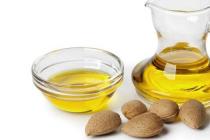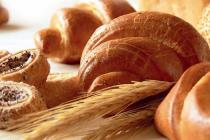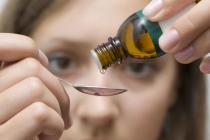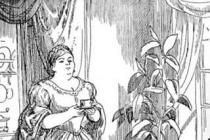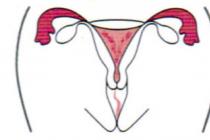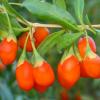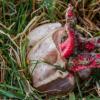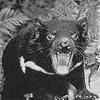Latin name: Mentha piperita.
English name: Peppermint.
Synonyms: noble, English, garden, tea, cold mint, cold mint.
Morphological description
Peppermint is a perennial plant up to one meter high with a branched root system, oval leaves and small purple flowers. The whole plant has a strong aroma. Blooms from late June to September. Good nectar plant. It is not found anywhere in the wild. There are two forms of peppermint - black and white. White mint blooms earlier than black mint, the aroma of the essential oil is more delicate, but the yield of oil and the yield of leaves are lower.
habitat
It is a cultural hybrid of M. viridis and M. aquatica, bred in England at the end of the sixteenth century. Naturalized in Europe and America, cultivated all over the world. Oil is produced in France, England, America, Russia, Bulgaria, Italy and China.
Collection of medicinal raw materials and used parts
Leaves are used, which are collected in the phase of budding and the beginning of flowering of the plant. The smell is pleasant, fragrant, the taste is burning, when chewing it causes a prolonged sensation of cold in the mouth.
Chemical composition
Essential oil, flavonoids, tannins, carotene (provitamin A), organic acids and bitterness are the main active ingredients of this plant. The most important component in the essential oil is menthol (up to 60%).
pharmachologic effect
In ancient Rome, rooms were sprinkled with mint water, tables were rubbed with the plant itself to create a cheerful mood among guests. Ancient physicians believed that mint was useful for a number of stomach ailments. The ancient Greeks and Romans believed that the smell of mint increased mental capacity. This belief was preserved in the Middle Ages: students laid wreaths of mint on their heads during examination debates. Modern science has established that the menthol contained in peppermint oil, when applied to the skin or mucous membrane, excites the receptors and causes a feeling of cold. Superficial blood vessels constrict, the vessels of the internal organs expand, while a slight local anesthetic effect is observed. Menthol has local anesthetic, antispasmodic and antiseptic properties, causes reflex expansion of the coronary vessels. As a vasodilator, it is used for angina pectoris, hypertension, atherosclerosis.
Getting on the nerve endings embedded in the mucous membrane of the stomach and intestines, peppermint oil enhances peristalsis. Mint preparations enhance the secretion of the digestive glands, promote faster emptying of the stomach and intestines, stimulate appetite, reduce nausea, and improve digestion. They are prescribed for gastrointestinal diseases, spastic colitis and enterocolitis, and dysentery. Peppermint oil also has a beneficial effect on liver function and is a choleretic agent.
Mint leaves are used as a sedative, tonic for neuralgia, insomnia, migraine. As an analgesic and anti-inflammatory agent, it is used for inflammation of the periosteum, middle ear and other diseases.
In cosmetics, mint is used as an antimicrobial, astringent that reduces skin irritation. Lotions and rubbing with infusion of mint tone the skin and relieve itching.
Peppermint leaves improve any tea collection with their taste and smell, and also enhance its effect, since medicines containing both essential oil, tannins, and bitterness have a multilateral effect.
Application
- - with diseases of the stomach and intestines, spasms and colic in the stomach;
- - with nausea and vomiting;
- - in diseases of the gallbladder and liver;
- - with angina pectoris;
- - with colds and fever;
- - with a headache;
- - with neuralgia;
- - with dermatitis, scabies;
- - with toothache;
- - to eliminate bad breath.
Products containing MINT:
- AG-X (AG-X) RU 1197
- CC-A NSP RU 896
Those who read this article also read:
|
|
|
Family Lamiaceae (Lyasnotkovye) - Labiatae (Lamiaceae).
Peppermint (lat.Mentha piperita ) is a herbaceous perennial, strongly bushy plant with a horizontally running rhizome. Numerous tetrahedral stems depart from the rhizome, slightly pubescent or bare, with numerous dotted glands. The color of the stems is blue-violet. Mint leaves are opposite, collected in cruciform whorls, ovate-lanceolate, sharp-toothed along the edge. On both sides they are dotted with numerous dotted glands, which are more numerous on the underside. Mint flowers are small, reddish-lilac, collected in apical capitate-spikelet inflorescences. The flowers are almost correct. The whole plant has a strong fragrance.
Popular name: cold mint.
Flowering time: June-September.
Spreading: Peppermint is not found in the wild, it is widely cultivated on plantations as a medicinal and essential oil plant. Field mint is widely distributed in the temperate zone of Europe, Asia and North America.
Place of growth: mint grows in damp meadows, along the banks of reservoirs. It is also cultivated as an essential oil and medicinal plant.
Applicable Part: leaves, flowering tops of shoots.
Collection time: July August.
Chemical composition: mint leaves contain many biologically active substances: tropsoline glycoside, sulfur-containing essential oil, potassium sulfate, phytosterol, ascorbic acid, sugar, starch, pectin, pigment sorbusin, etc. In essential oil leaves up to 2.75%, in inflorescences - up to 6%, in stems - up to 0.3%. Also isolated from the plant: carotene (up to 40 mg%), acids (ursolic and oleanic), triterpene compounds, hesperidin, flavonoids and betaine. Peppermint oil is a raw material for the extraction of menthol, used in alcoholic beverage production, perfumery.
Collection and preparation: leaves and tops of mint shoots are harvested in the phase of mass flowering, in the morning. Before drying, the raw materials are sorted, removing the browned parts, and then dried in the shade in the air or in dryers at a temperature of 40C. Store in a closed container in a dry place, as myta leaves are very hygroscopic and moisture makes them unfit for consumption. Shelf life - 2 years. Essential oil is extracted from mint herb under industrial conditions.
Contraindications: mint, whose contraindications are not great, still requires careful attitude and moderate consumption. Undoubtedly, with excessive passion for mint, insomnia may occur, heart pains may appear, and in some cases, a decrease in potency in men may occur. Here it is necessary to make a reservation - you should not be afraid of this plant, because mint for men is harmful only in excessive quantities. And on a non-permanent basis, it can and should be used.
Peppermint contraindications include individual intolerance, as allergic reactions may occur. Therefore, you should be especially careful, or even refuse to use it.
Mint can cause an exacerbation of an existing disease, in connection with this, mint should not be consumed by people with low blood pressure, as well as with reduced tone of venous vessels. Moreover, mint is contraindicated for children under 5 years old, as well as for women during lactation.
Application:
Mint has antispasmodic, analgesic, antiseptic, choleretic, carminative and some laxative effects. It is used as a cardiac stimulant and analgesic (for headaches), for the treatment of hypertension, angina pectoris and atherosclerosis. Recommended for colds of the upper respiratory tract, bronchial asthma and bronchiectasis.
Mint works well for dyskinesia of the biliary tract and intestines, improves digestion and increases appetite. It is used for gastritis, peptic ulcer, colitis, enterocolitis, flatulence, nausea, vomiting, sometimes with diarrhea (despite the laxative effect). Mint is added to herbal preparations for cholelithiasis, hepatitis, and cholecystitis.
Mint, along with potato juice and St. John's wort, is considered an effective remedy for heartburn.
Peppermint with regular use has a tonic and wound-healing effect, helps with hysteria, insomnia, migraine, and has a diuretic effect. Mint leaves improve the taste and smell of medicinal infusions, so it is advisable to add it to all fees.
Mint is used externally for baths. Peppermint oil is used for inhalation; it is a part of drops, mixtures, tablets (validol) and pencils.
Mode of application:
2 tablespoons of peppermint herb insist with 2 cups of boiling water (daily dose). Taken in 3 doses for 30 minutes. before meals.
Official Preparations: Peppermint oil (Oleum Menthae piperitae) contains 50% menthol, used in dental practice; inside - 1-3 drops per sugar (for flatulence); menthol (Mentholum) is used for skin itching and myalgia.
Mint is a part of olimetin (Olimetinum), enatin (Enatinum), candles "Anestezol", validol, Zelenin drops.
Ready-made medicinal collections - gastric, carminative and choleretic - contain peppermint leaves.
Mint is also used in homeopathy, Mentha piperita 3X-3 - for neurocirculatory dystonia and diseases of the gastrointestinal tract.
Mint- an odorous medicinal herb with simple stems and bright green leaves resembling nettle leaves (see photo). Mint has been familiar to everyone since childhood. In the people, this herb is known under the names "perekop" and "dragolyub". Most plant species are found in the Mediterranean.
According to an ancient legend, mint got its name from the name of the goddess Minta, who fell in love with the god of the underworld. Having learned about this, the wife of Hades turned Minta into a beautiful fragrant plant.
Central Asia and the Mediterranean are considered to be the birthplace of fragrant grass. Peppermint originated in England. Today, this fragrant plant of the Lamiaceae family is cultivated almost everywhere. Unpretentious grass often grows even with weeds.
Mint has more than 100 species, the most famous among them are peppermint, Japanese mint, garden mint, water mint, spike mint.
Medicinal properties
The medicinal properties of mint make it possible to use it not only in culinary recipes, but also for medicinal purposes. The ground part of the plant contains a large amount of essential oil, the main component of which is menthol. The essential oil gives the herb its characteristic smell and taste. Menthol is effective for sciatica, varicose veins, cellulite. The herb also contains other, no less useful components (flavonoids, tannins), but the plant exhibits bactericidal properties precisely because of menthol.
 Mint is considered a female plant: it lowers the level of male hormones and, accordingly, reduces hair growth in unwanted places. Mint infusion is recommended to be used to normalize the menstrual cycle, relieve pain and improve the general condition during menopause.
Mint is considered a female plant: it lowers the level of male hormones and, accordingly, reduces hair growth in unwanted places. Mint infusion is recommended to be used to normalize the menstrual cycle, relieve pain and improve the general condition during menopause.
Peppermint essential oil is widely used in cosmetology and perfumery, and not only in official and folk medicine. Mint toothpastes, chewing gums, mouthwashes are familiar to everyone. Essential oil, as well as products based on it, is well suited for the care of oily hair. Peppermint oil is also recommended for problem skin.
Application in cooking
In cooking, mint has found application in the form of fragrant tea. This drink is considered a good natural sedative. Tea is prepared very simply: a teaspoon of dried mint is poured into a glass of boiling water, for taste, you can add a little bee honey or a slice of lemon. In summer, you can make cold mint tea with ice: it will perfectly quench your thirst and relieve nervous tension. Mint pairs well with both black and green teas. It is recommended to add mint to soft drinks and dishes in advance so that the essential oil penetrates the ingredients. It is hard to imagine the famous Mojito cocktail without mint. The plant gives the drink a fresh taste and aroma.
 Mint leaves are widely used to decorate cakes and other desserts. In the preparation of confectionery, as a rule, mint essence or mint oil is used. Mint leaves give sweets a delicate aroma and appetizing appearance. The famous mint gingerbread is also prepared with this fragrant plant. Mint is used to make well-known candies. The calorie content of fresh grass is about 47 kilocalories per 100 g.
Mint leaves are widely used to decorate cakes and other desserts. In the preparation of confectionery, as a rule, mint essence or mint oil is used. Mint leaves give sweets a delicate aroma and appetizing appearance. The famous mint gingerbread is also prepared with this fragrant plant. Mint is used to make well-known candies. The calorie content of fresh grass is about 47 kilocalories per 100 g.
Dried mint is used in cooking as a spicy seasoning. A little dry mint is added to various sauces and marinades. Mint perfectly emphasizes the taste of meat and vegetable dishes. In order for mint leaves not to become bitter and spoil the taste of the main dish, it is recommended to add quite a bit of it, and shortly before readiness.
Mint is great for flavoring vegetable oil or vinegar. In order to get a minty flavor, just add a sprig of mint to a bottle of oil and leave the product to infuse in a dark place for several weeks.
Mint benefits and treatment
The benefits of the plant have been known to mankind since ancient times. In ancient Rome, for example, mint was used almost everywhere. The space at home was treated with mint water; before eating, dining tables were rubbed with mint leaves to improve mood and digestion. It was believed that the mint aroma activates the brain, so students were recommended to wear wreaths with dried grass.
Mint can cause some harm to the male body. The plant reduces the amount of testosterone in the blood and lowers the excitability of a man, making him calm.
Peppermint tea is contraindicated for people suffering from chronic heartburn.
With caution, mint infusions should be used by pregnant women: the plant can affect the formation of the fetus, especially if it is a boy. It is also undesirable for children to brew concentrated mint tea.
General informationFamily: labial - Lamiaceae.
Botanical name: Mentha piperita L.
Pharmacy name: peppermint leaves - Menthae piperitae folium, peppermint oil - Menthae piperitae aetheroleum.
Folk names: noble mint, English mint, garden mint, tea mint, cold mint, cognac mint.
Planet: Venus.
Planet:- Jupiter, Mercury
Zodiac sign: A lion.
Element: air.
Gods:- Dedicated to Aphrodite. according to Cunningham - patrons Pluto, Hekate
Flower language: Mint (pepper) - warm feelings in the language of flowers.
Basic properties: healing, cleansing, exorcism, travel, protection, passion.
Description:
Peppermint is a hybrid that was discovered in England. Peppermint is a perennial herbaceous plant, has a height of 50 to 120 cm. The rhizome of mint is underground, horizontal, located at a depth of 5 to 15 cm, quite branched. The stem of mint is an annual, straight, dark purple color. Fairly full, tetrahedral and branched. The tops of the main stem and side branches end in inflorescences. Peppermint flowers are small, pistillate, light purple, lilac or whitish-pink. The leaves of mint are green, small, have an elongated - oval (ovoid) shape, pointed. Mint blooms from June to August. Occasionally it can have a fruit that consists of 4 nuts, but this happens extremely rarely.
Places of growth:
Peppermint was bred in England, later mint was cultivated in Europe, America and even Asia. Peppermint can also be found in the CIS countries. As an industrial crop, peppermint is grown in forty countries. But such countries as Moldova (the forest-steppe part of the country), Ukraine (mainly the Chernihiv and Poltava regions - forest-steppe zones), Russia, or rather the Krasnodar Territory and the North Caucasus, as well as Belarus, are engaged in the largest cultivation of mint.
Used parts:
In cooking, mainly peppermint leaves are used, as well as aerial parts. All parts are collected during the flowering period.
Peppermint flowers are harvested at the time of flowering. And the leaves are collected several times a year. The first time the leaves are cut off immediately after regrowth, the second time the leaves are collected just before the flowering of the plant. Leaves and aerial parts are dried in places closed from the sun, in the shade. This way they retain their flavor and color. Store properly dried mint for a long time, about two years. Provided that the storage place is dry, dark and in sealed packaging.
Medicine:When using peppermint in tea, you can treat the stomach, as a decoction of mint is an effective gastric remedy. Peppermint tea helps with nausea and vomiting. A decoction, or rather an infusion of peppermint, can effectively cope with gastrointestinal diseases, as well as spasms. Taking a warm decoction or tea three times a day, one cup. Peppermint promotes the outflow and secretion of bile, which is important for cholelithiasis. Peppermint is part of many tea medicinal collections, which are intended for the prevention or treatment of diseases of the stomach, intestines, liver. The healing action of peppermint soothes headaches and palpitations. Peppermint also helps with sleep disturbance. Peppermint has antiviral and antibacterial activity for colds. It is an antipyretic and anti-inflammatory agent. Peppermint is used as a vasodilator.
Active substances:
The chemical composition of peppermint includes tannins, bitterness, as well as flavonoids. In addition, peppermint contains menthol, which is contained in 60% of the essential oil. In addition, the essential oil contains menthon, carvacrol, cineole, pinene, limonene, dipentene, pulegone. The leaves contain glucose, organic and other acids. Mint also contains vitamin C, betaine, carotene, rutin and hesperidin.
The role of mint in folk medicine is very high. And therefore, in most home first aid kits, you can find peppermint, along with chamomile. And in folk medicine, peppermint is used to relieve headaches, with migraines. Let's say fresh leaves are simply applied to the temples. In addition, peppermint is used to treat certain skin conditions. To do this, a pepper napkin moistened with mint juice is applied to a sore or affected area on the skin. Mint leaves are also used for inflammatory processes, burns. They drink a decoction of mint for hoarseness and hoarseness, as well as for bronchitis, laryngitis and other diseases of the upper respiratory tract. Used as an antiseptic. It is also actively used for toothaches, such as caries, gum inflammation or stomatitis. And also with nervous excitement and with manifestations of symptoms of seasickness. Peppermint is used as a fresh leaf: applied to wounds, ulcers or boils. And also in the crushed form of dry leaves it is used to treat abscesses, thereby accelerating maturation. Mint can optimize cerebral circulation.
Magic:Peppermint is often endowed with magical powers. And not in vain they endowed. After all, mint could ward off evil spirits. Peppermint, which has a rather bright and strong aroma, was unpleasant and even hated by evil spirits, who in principle could not stand it. Mint, having magical qualities, easily copes with a negative mood and severe overwork. I actively use mint for magical purposes, during purification rites, some ceremonies. And also mint is popularly used for the preparation of various amulets or talismans, as well as for various cleansing or healing incense. For example, to clear a space, you need to burn a few sprigs or mint leaves. Peppermint is actively used by magicians to enhance attention. And it is used in potions that are designed for this. Peppermint is also able to relieve tension, which is very often present in magicians during work. The magical properties of mint are healing and cleansing.
To attract money - put a few mint leaves in your wallet / purse or rub mint on the place where the money is.
Getting rid of spirits: sprinkle the room with salt water, dropping a sprig of mint, rosemary and marjoram into it.
Once upon a time, fresh mint was placed on the altar to call good spirits that helped in magical actions. And in case of stomach diseases, they offered to make a doll out of green matter, stuff it with mint and rub it with healing oils.
Mint, taken on a trip, will help make it safe.
Mint, worn on the wrist, protects against diseases.
Mint is also used to arouse carnal passions.
Of course, peppermint has been known since ancient times to people and gods. Peppermint got its name from a Roman goddess whose name was Menta. The goddess personified the mind, the human mind. There is a myth associated with peppermint. And the essence of the myth is that, Pluto, the Roman god long and diligently sought the favor of the nymph Menta, and his jealous wife Persephone pursued the poor nymph, and her jealousy reached the point that she simply trampled Menta into the ground. But, Pluto, who continued to love Menta, turned her into a wonderful plant - peppermint. Wreaths of mint liked to decorate the ancient inhabitants of the head during feasts. Based on the fact that it had detoxifying properties. And also in ancient times, both people and gods liked to add mint leaves to nectars and wine. Unlike the ancient Greeks, among the Jews, peppermint was considered a fairly strong aphrodisiac, and therefore was universally included in the composition of perfumes and various aromatic waters. There is a belief that peppermint is a female herb, and therefore, in many cosmetic products, peppermint or peppermint itself is used. There is another belief that has its roots in ancient times. Even in ancient times, the hostess nourished the floors and tables in the house with peppermint, thereby creating a joyful mood, both for herself, her family, and for visiting friends. And also in the Middle Ages, wreaths were laid on the heads of students who take exams, thereby improving mental work.
Recipes, infusions, decoctions:Peppermint is often used to prepare preventive, curative, and other potions.
For example, to prepare a healing potion that helps to cope with stomach upset and pain Required: Two tablespoons of dried crushed leaves in 2 cups of hot water, which is approximately 500 ml of boiling water. Drink 1/3 or half a glass 2-3 times a day half an hour before meals.
But for prevention attacks of hypertension you can make a preventative potion. For this you will need: 1 part peppermint, 1 part chamomile and half a part valerian. An infusion is prepared from these components, which is taken orally 1/3 cup a day. And one more wonderful potion recipe, which is very necessary in the cold and flu season.
For cooking cold potion Required: 1 tablespoon peppermint and water. Boiling water is poured over mint and infused for 10 minutes. Then consumed inside in a warm form.
Peppermint is a spice that is very often used in cooking. Mint can be added to a wide range of dishes. Whether it be vegetable salads, fish or meat dishes, soups, desserts and much more. Mint is also used simply for decorating and decorating dishes. After all, you can often find ice cream balls in restaurants, which are decorated with mint leaves. Mint is a wonderful honey plant, and therefore fragrant and healthy honey is obtained from it. He loves peppermint cottage cheese, as well as soft cheese. Since these products improve their quality, as well as the aroma when adding fresh peppermint leaves. Peppermint is also added in the manufacture of vinegar with herbs or vegetable oil, where mint leaves are necessarily added along with other aromatic herbs. Mint is often added to various baked goods. Starting from simple bread, ending with delicious cakes and desserts. Mint also improves drinks, compotes, kissels, fruit drinks and other drinks. Of course, mint is added to both tea and kvass. Kvass recipe: In order to prepare kvass, you need to take a three-liter jar and add 300 grams of mashed rye crackers and insist everything for several hours, then drain the resulting liquid, then add a few mint leaves, and then pour about a glass of sugar and a few grams of live yeast. Infuse for half a day, that is, 12 hours, after which the resulting strain and pour into bottles for storage, you just need to add a few raisins or a few cranberries. Let it insist again and after a couple of days the kvass is ready for use. Mint is often used in drinks during the summer months, as the menthol it contains gives a slightly chilly sensation. And one more recipe. Delicious barbecue marinade. For the marinade you need: salt, peppercorns, vegetable oil, seasonings, peppermint and, of course, meat. There are not so many ingredients, but the taste of the kebab is surprisingly pleasant, and the meat is soft and juicy. In addition, mint serves as a flavoring in various cocktails, drinks and baked goods.
PEPPERMINT- English Peppermint German Pfefferminz French Menthe poivrée Latin Mentha piperita L. (Labiatae) ... Phytopathological dictionary-reference book
Peppermint- (English mint, cold mint, cold mint, chill mint) Menta piperita L. Lamiaceae family. Perennial herbaceous plant 30-100 cm high, with a characteristic strong odor and a cooling sensation when chewing the leaves. Rhizome ... ... Encyclopedia of Medicinal Plants
PEPPERMINT- Cuisine: Cuisine of the Maghreb countries Type of dish: Main courses Cooking recipe … Encyclopedia of culinary recipes
peppermint- pipirinė mėta statusas T sritis augalininkystė apibrėžtis Daugiametis, stipriai kvepiantis, žolinis, prieskoninis, vaistinis, medingas notrelinių (Lamiaceae) šeimos augalas. Sėklų nesubrandina. Dauginamas šakniastiebiais. Prieskoniams vartojami… … Žemės ūkio augalų selekcijos ir sėklininkystės terminų žodynas
Perennial herbaceous plant. from the family labial, not found in the wild. The leaves of M. p. contain 2-3% essential oil, which determines the cooling taste and strong aroma of this plant. The essential oil of M. p. is widely used in perfumery, ... ... Agricultural dictionary-reference book
PEPPERMINT- (Mentha piperita), a perennial herbaceous essential oil plant of the family. labial. For medicinal purposes, the leaves of L. p. (Folium Menthae piperitae; FH), collected during flowering, and the oil of L. p. (Oleum Menthae piperitae; FH) are used. Gl. ... ... Veterinary Encyclopedic Dictionary
MENTHA PIPERITA L. - PEPPERMINT, ENGLISH, COLD- see 831. Perennial plant. M. piperita L. M. pepper, English, cold Sp. pl. (1753) 576. Urinson (1938) 81. Hocking, Edwards (1955) 78. Wealth of India 6(1962) 342, f. Atlas lek. rast. (1962) 370, fig. Syn. M. piperita Huds. var.… … Plant Directory




